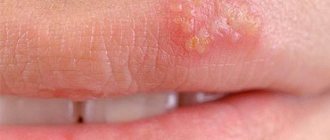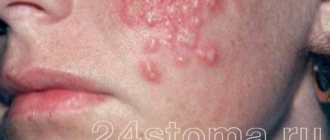Many people are familiar with the expression “ cold lips . It is usually used when a bubble with transparent contents forms in the lip area, which subsequently bursts and the affected area becomes covered with a crust. Cold sores are an infectious disease caused by the herpes simplex virus type 1 or 2. The source of infection can be infected people, both with and without pronounced signs of herpes. Cold sores on the lips are not limited to the presence of the virus only in this area. In patients the herpes virus is detected in such body fluids as blood (including menstrual fluid), urine, discharge from the nose and tear ducts, vaginal secretions, amniotic fluid and sperm. How the virus is transmitted and how to treat herpes is discussed in this article.
How does herpes infection occur?
As mentioned above, colds on the lips are caused by two types of viruses - herpes virus type 1 and herpes virus type 2 . Infection with herpes virus type 1 mainly occurs in childhood and adolescence. The main routes of transmission of infection are contact (for example, through personal objects) and airborne droplets (by inhaling the virus, kissing). However, infection can also occur through oral-genital contact. Infection with herpes virus type 2 occurs through direct sexual contact and is therefore more common among young people and adults. Transmission of pathogens of both types 1 and 2 can occur from mother to fetus (transplacentally), and also in isolated cases through infected blood products (parenterally). It is worth noting that the risk of infection increases significantly if an infected person has herpetic rashes on the skin and mucous membranes.
Prevention
For those infected with herpesvirus type 1, it is generally almost impossible to completely avoid the appearance of cold sores on the lips. You can only reduce the risks of its occurrence due to reactivation of the virus. To do this, first of all, you should use the usual methods of maintaining immunity (a healthy lifestyle, a nutritious and varied diet, a minimum of stress, etc.). However, herpes on the lips can also occur unexpectedly, for no apparent reason.
Particular attention should be paid to prevention for infants and young children, since primary infection can have serious consequences due to imperfect immune defense. It is believed that it is most important to avoid too early infection with herpes viruses (which is almost inevitable later), for example, transmission of the virus from a nursing mother. If signs of a herpetic lesion appear in the mother or surrounding people, precautions should be taken: no close contact with a small child, stricter personal hygiene.
Request a consultation
Forms of herpetic infection
There are several forms of herpes infection. The bullous form of herpes is characterized by the appearance of blisters that can reach the size of a plum. The abortive form occurs without the formation of a blistering rash, and at the site of the lesion there is swelling and small cone-shaped elevations above the surface of the skin or mucous membranes. The most severe forms of herpes are ulcerative, ulcerative-necrotic and gangrenous. They are characterized by the appearance of vesicles with hemorrhagic contents, the appearance of long-term non-healing deep ulcers that leave scars. The development of the gangrenous form occurs in people weakened by any diseases, as well as in elderly patients with gastric ulcers, diabetes mellitus and other concomitant pathologies.
Types and stages of development of hordeolum
Depending on the location of the lesion, it can be of the following types:
- External stye
. More common according to statistics. The infectious-inflammatory process is localized at the edge of the eyelid, since the infection settles in the sebaceous gland of Zeiss or in the ciliary bulb. - Internal stye on the eye
. It has another name - meibomite. It is caused by the penetration of pathogenic microorganisms into the passage of the meibomian glands located on the back side of the eyelid margin.
By type they distinguish:
- Hot barley
. It is characterized by the classic development of the disease; infection is localized in the ciliary pocket - the bulb or Zeiss gland. With therapy it goes away in about a week. - Cold stye (chalazion, meibomian cyst)
. The inflammatory process affects the meibomian glands. It develops very slowly. Recovery takes 1–2 months. If there is a very large stye, surgical removal is possible.
Inflammation goes through the following stages:
- Formation of a purulent core
. A small reddish swelling causes discomfort when moving the eyelids. - Formation of an abscess
. The patient’s condition at this stage can only be alleviated by medications. - Breakthrough of pus.
It does not indicate recovery, but the patient feels much better. During this period, you need to keep your eyes clean and use prescribed medications and ointments.
Provocateurs of herpes infection
Colds on the lips rarely have an acute form; a chronic course of the disease is much more common. According to WHO, approximately 70% of people around the world are infected with the herpes simplex virus and about 10-20% of patients experience various symptoms of herpes infection. Exacerbations of chronic herpes occur for a number of reasons. The main factors that lead to relapse are emotional and physical stress, hypothermia, sexual intercourse, menstruation in women, concomitant diseases (ARVI, including influenza), ultraviolet radiation and others.
Causes of the disease
Herpes is an infectious disease. This is a virus that enters the body in different ways:
- sexual;
- contact (household);
- airborne (sneezing, coughing);
- placental (from a pregnant woman to a child).
In this case, herpes is most often transmitted by contact. The virus lives in saliva, so a person can become infected through a kiss, toys, underwear, dishes and other objects.
There are several factors that provoke the activation of the virus:
- constant stress;
- depressive states;
- prolonged hypothermia of the body, including one-time hypothermia;
- ARVI with and without complications;
- diseases that suppress the human immune system;
- bad habits, especially alcoholism, unhealthy diet;
- severe intoxication;
- Alzheimer's disease.
Herpes is present in the body of almost every person, but most of the time it is in an inactive state. Usually the virus “wakes up” against a background of weakened immunity. This can happen for various reasons, including against the background of severe stress, lack of sleep and other unfavorable factors.
Why is the herpes virus dangerous?
The herpes simplex virus affects many organs and systems. Herpetic blisters can appear on the mucous membranes of the vagina, cervix, urethra, mouth and skin, and with an extensive process they can appear in the liver and brain. Herpes can cause dysfunction of both the autonomic and central nervous systems. In addition, the herpes virus is associated with cancer, unfavorable pregnancy, childbirth, as well as pathologies in the fetus and newborns. According to the World Health Organization, the mortality rate from severe forms of the herpes simplex virus is 15.8% compared to other viral infections and ranks second after deaths from influenza (35.8%). In our country, the number of patients diagnosed with herpes infection every year exceeds 2.5 million. Patients with chronic herpetic lesions of the skin and genitals make up more than 10% of the total population of Russia.
Additional measures
Some categories of patients are particularly sensitive to certain drugs. For some they are completely contraindicated. Additional measures must be taken to treat such patients. So, in the first trimester of pregnancy, taking medications is generally undesirable. It is better to use folk remedies. In the last three months you should not drink a lot of liquid. Although this helps to cope with ARVI, the consequences can be serious. Sodium leaching and kidney overload are very dangerous for a pregnant woman.
When treating children under three years of age, essential oils are contraindicated. If they help an adult to recover, in a child, the course of the disease, on the contrary, may become more severe. In addition, the risk of an allergic reaction from an incompletely formed immune system cannot be ruled out.
Treatment of herpes
The herpes virus enters the body through the mucous membranes and settles in the nerve ganglia for life. Therefore, it is impossible to completely get rid of the pathogen. However, with proper therapy, it is possible to reduce the intensity of the rash, significantly reduce the duration of the prodromal period and reduce the frequency of exacerbations. Treatment of herpes at home includes antiviral therapy using antiherpetic drugs. But since colds on the lips are accompanied by immunodeficiency, the treatment regimen also includes immunomodulatory agents, for example, interferon preparations or its inducers. In the combined treatment of herpes, the drug Viferon can be used, which resists viruses and corrects protective functions. Using the drug in a treatment regimen allows you to quickly relieve the symptoms of herpes and prolong remission. In addition, the good tolerability of the drug makes it possible to use it in children and pregnant women.
Based on materials:
1. Malinovskaya V.V., Delenyan N.V. et al. "Viferon". Guide for doctors. M. 2004. 6. Malinovskaya V.V., Uchaikin “Viferon (suppositories and gel) in the complex therapy of herpes virus infections”, A.A. Haldin, D.V. Baskakova, A.N. Vasiliev. 2. “Algorithm for the treatment of exacerbations and secondary prevention of herpes simplex with Viferon”, A. A. Khaldin, I. V. Polesko. 3. “Algorithm for the treatment of exacerbations and secondary prevention of herpes simplex with Viferon”, Haldin A.A., Polesko I.V.
Loading...
Take other surveys
Cure a cold in one day
Medicines that are freely sold in all pharmacies will help us with this. Our goal is to quickly eliminate symptoms.
| Symptom | What do you need | Examples of active ingredients |
| General weakness and fever | Antipyretic, anti-inflammatory, analgesic | Ibuprofen Paracetamol |
| A sore throat | Antiseptics | Hexethidine Biclotymol Ambazon |
| Runny nose | Antiseptics, decongestants, vasoconstrictors | Xylometazoline Sea water Phenylephrine |
| Cough | Secretolytics, mucolytics | Ambroxol Bromhexine Thermopsis herb Ginger rhizome extract Acetylcysteine |
Classification of herpes viruses
Researchers have identified 8 strains of herpesvirus that can infect humans:
- First. Causes inflammation of the lips and mouth (labial herpes). In rare cases, it can cause genital rashes.
- Second. Affects the genitals and groin area. Causes genital or vaginal herpes. Less commonly, it is the causative agent of oral herpes.
- Third. Causes chickenpox and shingles.
- Fourth. Known as Epstein-Barr virus. Causes mononucleosis, lymphomas and carcinomas.
- Fifth. Cytomegalovirus. Causes mononucleosis, hepatitis, herpetic retinitis.
- Sixth and seventh. Roseoloviruses. They cause roseola, exanthema. May be one of the causes of chronic fatigue.
- Eighth. Causes lymphoma, Kaposi's sarcoma, Castleman's disease.
The causative agent of herpes simplex is herpesvirus type I or II. There is a misconception that the disease cannot be cured. In fact, herpes is curable. Although modern medicine cannot completely remove the virus from the body, it is possible to suppress its vital activity so much that it stops causing inconvenience.
Preventive measures
Prevention includes following the recommendations:
- Strengthening immune forces
. This should always be done, not only when there is a threat of hordeolum or in the off-season. It is recommended to take vitamins, give preference to fresh vegetables and fruits, move more, be in the fresh air, and follow a daily routine. - Timely elimination of ophthalmological disorders
. If you are prone to eye diseases, you should regularly visit an ophthalmologist. Self-diagnosis and self-medication usually contribute to the transition of pathology to a chronic form. - Compliance with hygiene standards
. You need to have your own towel, wash your hands with soap, change bed linen every 1–2 weeks, and not use other people’s cosmetics. - Developing the habit of not touching your eyes
. This should not be done even in a normal state, when a person is not bothered by any problems. This rule also applies to the face - you should not touch it during the day with unwashed hands.
Simple preventive measures will help avoid inflammation and keep your eyes healthy.










